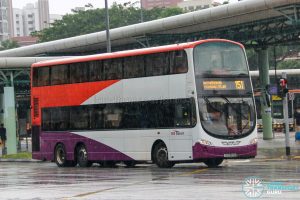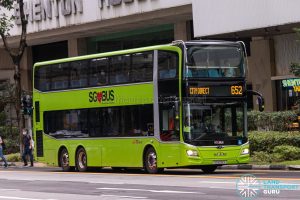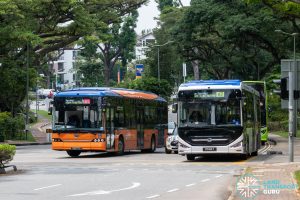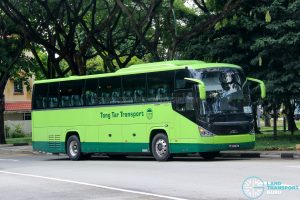Singapore’s extensive network of public bus services forms the backbone of the public transport system, complementing the rail network and providing essential connectivity to all corners of the island. The public bus network is vital to Singapore’s transport policy, which promotes a car-lite society, with a robust bus network essential to achieving this goal.
In 2023, public buses in Singapore recorded around 3.75 million passenger trips daily, across 350 bus services. As of May 2022, the public bus fleet comprises around 5,800 buses with an average age of eight years.
Currently, public bus services are operated by four main bus operators (SBS Transit, SMRT Buses, Tower Transit, Go-Ahead) under the Bus Contracting Model (BCM). Under this model, the Land Transport Authority (LTA) (and by extension, the Government) retains ownership of all bus assets, including buses, infrastructure, and systems. Operators are contracted through a tendering process to operate, manage, and maintain these assets. Bus fares are charged based on distance travelled, and are also regulated by the Government.
In addition to these services, private bus operators offer Premium services and other Shuttle Bus services which further enhance the accessibility and convenience of public transportation options in Singapore.
Types of Public Bus Services
Trunk & Feeder Bus Services
Main Article: Basic Bus Services
Trunk services are the main arteries of Singapore’s public bus network, running long routes that connect various neighbourhoods and towns across the island, including routes into the city areas.
Feeder services, on the other hand, operate within specific neighbourhoods. Typically based out of bus interchanges with rail connections, these services provide crucial links within housing estates and play a pivotal role in Singapore’s hub-and-spoke transport system, which prioritises the rail network for long-distance trips, and buses for last-mile connectivity.
Some feeder services also operate in a dual-loop fashion (formerly known as Townlink or Intratown services). These routes serve as feeder services between neighborhoods and the town centres, while also connecting different neighborhoods within a town, eliminating the need for bus transfers at the interchange.
Operating alongside these basic bus services are route variants introduced to ply variants of their parent trunk routes, usually indicated by an alphabetical prefix or suffix attached to bus service numbers. Common ones used include A, B, and C for Short-Trip Services, M for ‘Modified’ / Route Variants, and T for Terminating trips of Feeder services. A full list of these services can be found at Bus Service Prefixes and Suffixes.
Several types of bus routes that are subsets of trunk/feeder routes are:
- Short-Trip Services: Shortened versions of trunk/feeder routes
- Cross-Border Services: Connecting Singapore and Johor Bahru
- Jurong Industrial Services: Serving Jurong Industrial Estate (branding largely defunct)
Public buses are also deployed on Rail Replacement Services during extended rail disruptions.
Express & City Direct Bus Services
Main Article: Express Bus Services / City Direct Services
Express Services are designed with express sectors that involve skipping certain bus stops or utilizing expressways, resulting in shorter commuting times compared to regular trunk services. These services charge express fares due to their added convenience and time-saving benefits.
City Direct Services, on the other hand, operate during weekday peak hours between major residential estates and the Central Business District (CBD). These services charge express fares, and offer commuters an alternative to existing public transport connections to the CBD.
Employee bus services are for public transport workers and not for the general public.
Private Bus Services
Private bus services are run by private bus operators according to set timetables and routes. They enhance the public transport network by meeting specific transportation requirements, such as transporting commuters to workplaces or leisure destinations. These services are regulated by LTA under a Class 2 Bus Service Licence.
Premium Bus Services
Main Article: Premium Services
Premium Bus Services typically ply between major residential estates and key industrial/commercial nodes such as the Central Business District (CBD) or Industrial/Business Parks during peak hours. Designed to ease the rush-hour crowd, Premium Bus Services charge a premium fare but offer a more direct connection as compared to existing public transport options. Premium Bus Services are operated by private bus operators based on commercial considerations.
Shuttle Bus Services
Main Article: Shuttle Bus Services
Shuttle Bus Services are provided to meet specific transportation needs, including connections to places of interest, tourist attractions, commercial or retail centres, and medical institutions. These services are typically run by private bus operators and may operate either as fare-collecting or free shuttle services.
Regions with internal shuttle bus networks include Changi Airport, NUS/NTU university campuses, and Sentosa Island.
Cross Border Services
Private buses also operate cross-border bus services, connecting Singapore and Johor Bahru. More at Cross-Border services.
Scheme B Bus Services
Main Article: Scheme B Bus Services
Scheme B Bus Services (complement existing basic bus services by providing additional capacity primarily during peak hours. These services are provided by private bus operators, such as private-hire or school bus operators. These services are not well-known owing to low outreach and infrequent departures.
Legacy Services
Several categories of public bus services that have been discontinued since the 2000s include NightRider, Nite Owl, Parks, Chinatown Direct, Bus Parallel Service, Cityshopper, Citybuzz, SMRT Nightbus, Stadium Direct and City Shuttle Services.
Services discontinued before the 2000s include SBS Blue Arrow services, National Stadium special services, CBD special services, and SS-prefixed temporary shuttle services.
References:
- LTA | Bus [Accessed 4 Jun 2024]
- LTA | Bus Network [Accessed 4 Jun 2024]
- LTA Public Transport Statistics [Accessed 4 Jun 2024]







I agree with I Dont Know , the services at there anchor terminal should be under the right bus package
Here are some services that go in the wrong packages:
SMRT 110 Compassvale to Changi Airport (Should be under Sengkang-Hougang Package, not Woodlands Package)
Yishun Feeder Services (Except 801) and Services 850E, 851, 851e, 852 should be under Tower Transit (Yishun ITH Anchor operator so it makes more sense to make it any anchor operator than Seletar taking more than half of the former anchor operators service.
Also in Woodlands, Services 963, 963e, 966 should have stayed under SMRT Woodlands Bus Package
instead of transfering to Sembawang-Yishun Package Tower Transit, and 963, 966 dont ply Sembawang or Yishun
Clementi Feeders and 96 should have stayed under SBST as usual not transfering to Tower Transit Bulim Package
Both Clementi And Yishun have none proper Feeder services from the Interchange’s Anchor Operator
Would make more sense if:
SMRT 110 transfer to SBST 110 under Sengkang-Hougang, instead of SMRT Woodlands Package
SBST all Yishun Feeders and SBST 850E, 851, 852 transfer to Tower Transit Sembawang-Yishun instead of Seletar
and Clementi Feeders and 96 should have stayed SBST instead of transfering to Tower Transit Bulim
and 963 and 966 should have stayed under SMRT Woodlands Package